Did you know that you can open up your new blog for guest bloggers?
Why would you want to have submissions as a blog strategy?

And how do you open up your blog for guest writers?
There are multiple ways to increase blog traffic and one way is to turn your blog into a contributor blog.
This is a blog that has multi-authors and allows for a blog content calendar with fresh posts weekly, bi-weekly or daily.
And the blog traffic you gain can come from the writers sharing your blog post on their blog – or better – linking to your blog on bigger sites. This is a great SEO strategy.
For example, Freelancer FAQs is an older contributor blog I own.
I have freelance writers guest post on this blog as a way to build their portfolio and credibility as as writer.
I’ve had popular freelance writers contribute to FreelancerFAQs as well as brand new writers wanting to grow their business.
This has lead to great backlinks from contributors – for example, contributor Sharon Hurley Hall linked to FreelancerFAQs in a Crazy Egg post about CRO.

As a mom blogger there are several reasons why you would want to turn your blog into a guest blog.
One big reason is if you give birth to a new baby. Most likely blogging won’t be on the front burner of your mind when giving birth 🙂
Many mom bloggers take a break from blogging and know that if they do that – there are no new blog posts published – traffic suffers and followers stop following.
Ouch! You don’t want that.
So there are two ways you can go about that:
- Create blog posts before you take your break. But this means doubling your content and if you aren’t feeling it or don’t have the time, this may not be an option.
- Get guest bloggers to submit a guest post for your blog.
But this strategy is a short-term way to open up your blog for guest writers. Once the mom is ready, she’ll continue blogging.
Another reason mom bloggers may start a contributor blog is if they want to change their blog traffic and monetization strategy. Having a guest blogging site means the potential for an increase in blog traffic at a faster rate than you would with a typical blog.
Why?
You’ll have more content to share and promote over a shorter time.
I started a new contributor blog, Imperfectly Perfect Mama, and was able to quickly grow blog traffic and get many submissions for blog content.
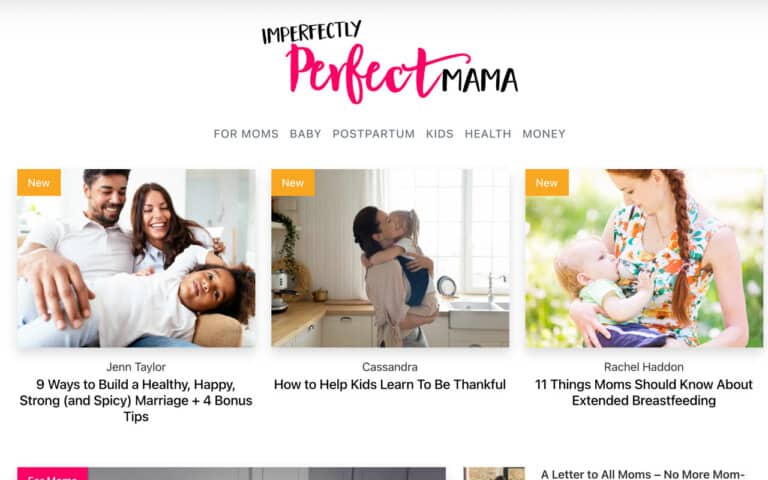
I didn’t want to start another blog as I already have several. So, instead of sitting on this new blog I picked up, I turned it into a guest contributor blog. And, as a mom blogger, you can do this too with a new blog.
(haven’t started a blog yet? Make sure to check out my step-by-step tutorial on starting a blog. You can create a new blog and turn that into a guest blog!)
So, what’s the process to opening up your blog for guest writers? Here is what I did to turn Imperfectly Perfect Mama into a guest blog.
3 Types of Blogs for a Guest Blog
I’ve found that there are generally three types of blogs that you can use for guest blogging:
- Create a new blog
- Take over an existing site
- Use your current blog
The best option – by far – is to take over an existing site.
This means finding a blogger that no longer wants to blog. You can ask your email list or ask on social media if there are any bloggers that don’t want to blog anymore.
I posted in my Facebook group that I was looking for another blog.
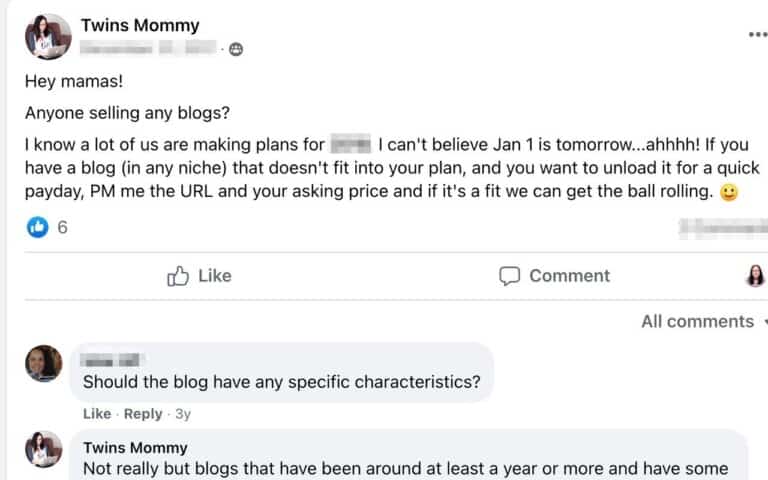
I was fortunate to find a blog that was established.
This blog was a year old and had social media profiles set up as well as two Facebook groups.
When finding an an existing blog you want to have a blog that’s at least a year old and – if possible – social media profiles like Pinterest and Facebook.
Similarly, you can open up your blog to guest writers. Whether you’ve been blogging for three months or just started your blog today, you can open it up to guest writers.
If you have a new blog or you bought an existing blog, set up social media profiles for your guest blog if it doesn’t have any. I suggest:
- A Facebook page
- Pinterest profile
These three platforms can promote daily or multiple times a day.
Also, create a separate Google Analytics for your contributor blog.
Install 2 WordPress Plugins
To turn your existing blog into a guest blog, you’ll need these two plugins:
Okay, you don’t NEED the related post plugin, but it’s a great way to market your blog content when most of your initial blog traffic will come from new users who don’t know your blog content or blog niche.
As a freelance writer, I value having an author bio on my client’s content.
I want to market my freelance writing service on my client’s blog and you should allow any guest bloggers that create FREE content for you a place to market their blog and business.
It’s a best blogging practice in my book!
If you don’t use a plugin, you can just place the author bio at the end of the blog post, but a plugin makes it look more professional.
And, if your theme supports author bios then use that version.
Or, you can create an Author Bio reusable block in WordPress.

WordPress Pages for Your New Guest Blog
You’ll need to create some pages for your contributor blog:
- Write for Us Page
- Contributor page (optional)
The Write for Us page is the guest post guidelines page.
On your guidelines for contributors make sure to include these sub topics:
- The blog’s audience
- What type of topics you have on your blog
- The type of topics you want from your guest bloggers
- What the guest writer will gain from sharing a blog post of there’s (i.e. potential traffic, a new audience, etc..)
- Guidelines on how to write a blog post for your blog (i.e. word count, use of H2 or H3 subheadings, a call-to-action or types of posts like a list post)
- A write up of how to submit their guest post to you
- A link to your email address to pitch their guest post ideas
- How long the content publishing schedule is
The contributor page is optional for your guest blog. This is a page dedicated to the guest writers.
Since Imperfectly Perfect Mama is a community of moms, I wanted to feature any guest writer as much as possible.
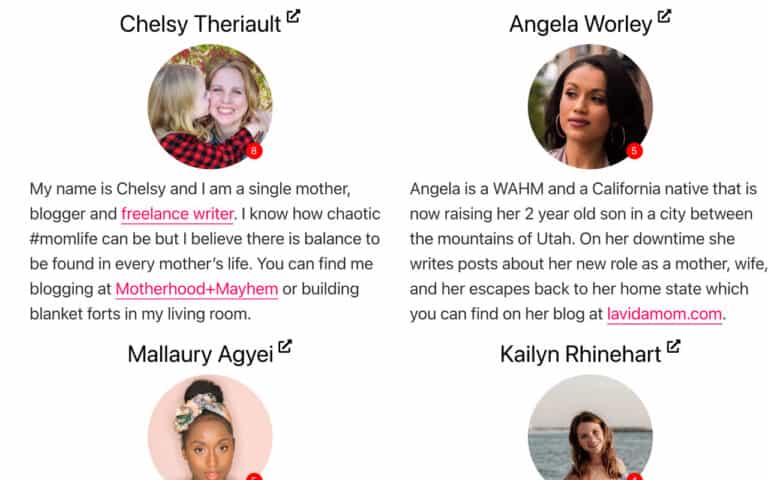
WordPress Role for Contributors
WordPress has roles for users:
WordPress uses a concept of Roles, designed to give the site owner the ability to control what users can and cannot do within the site. A site owner can manage the user access to such tasks as writing and editing posts, creating Pages, defining links, creating categories, moderating comments, managing plugins, managing themes, and managing other users, by assigning a specific role to each of the users.
The way I suggest you open your blog for guest writers is to assign them a role in your WordPress blog. Here are the main roles you can assign writers:

The one I use is the contributor role. This role means the writer can’t add images to your blog post or edit the blog post once they submit their post for review.
Process of Creating a User Profile for a Guest Writer
When someone wants to guest post on your blog, here are the steps I use for Imperfectly Perfect Mama.
1. Guest Blogger Emails Pitch Idea
I created a separate email account for Imperfectly Perfect Mama. So, when someone pitches a blog post idea, I’ll receive it as an IPM email.
Here is a typical submission email I receive from other mom bloggers:
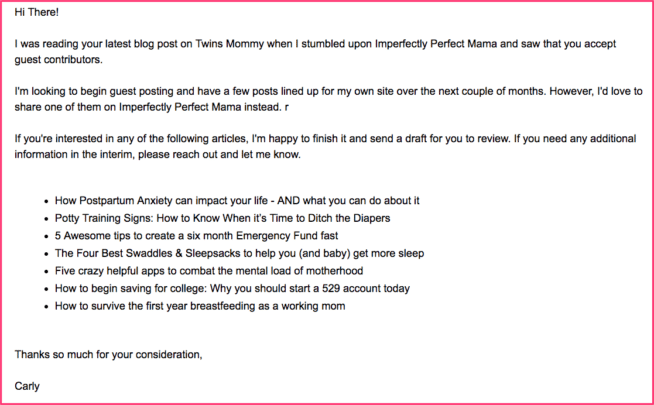
I review the email and make sure the blogger has a blog and is a mom. If the blogger doesn’t give me blog topic ideas, I email them again asking for some ideas before we get started on the next step (I say that in my email).
2. I Email Them The Next Steps
Otherwise, if everything checks out right, I email them information on the next step:
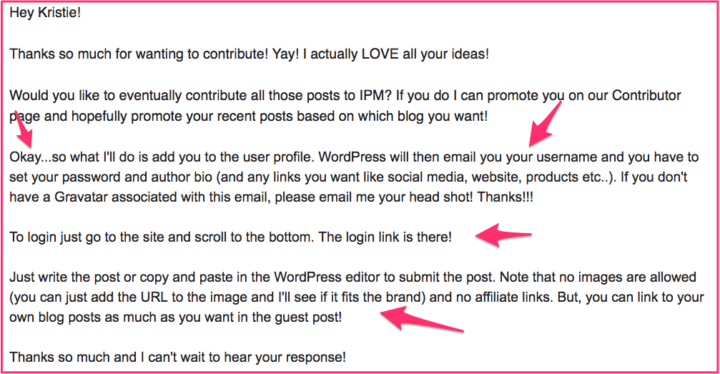
The important information in this email are:
- That I will create a user profile
- That WordPress will email them their user profile so they can create a password
- To email me their headshot if they don’t have a Gravatar associated with the email they used.
- How to login
- How to contribute a post and what is or isn’t allowed in your post
3. Create a User Profile for the Guest Writer
Here is what I do on my end to create a user profile:
In WordPress go to Profile > Add New.
Fill in the profile with the information you have from the email. Make sure to change the role from subscriber to contributor. Also make sure the box is ticked for “send new user an email about their account.”
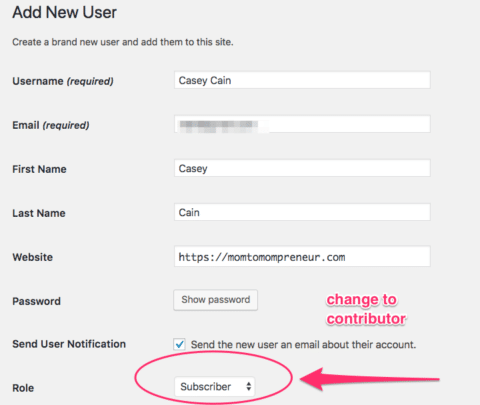
Then hit Add New User.
That’s it. If the user doesn’t have an image, you can email the blogger for a headshot and manually upload the image to your media library and add that to their user profile.
Here’s what the guest blogger needs to do:
Once WordPress emails them their user profile they can log in and update their user profile with their social media links and create an author bio.
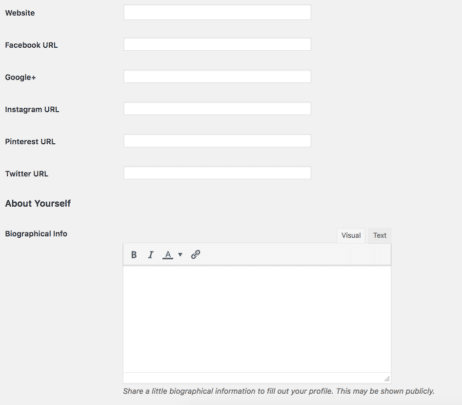
The guest blogger can then go to Posts and write their post.
Editing Process for Guest Post Submissions
Currently there are around 5 pending posts waiting for me to edit.
Depending on how many contributors you get or submissions you receive, this process can be handled by a Virtual Assistant or by you.
Currently, I’m handling most of the editing for each submission piece. This is what I typically do:
1. Work on the Headline to Create a SEO Title
Since Imperfectly Perfect Mama is a year old, I want to gain some search engine traffic along with Pinterest traffic.
To do this I need to focus a bit more on SEO – search engine optimization.
I search in Google for keyword phrases and look at how popular search terms are.
Typically, when a post does well on Pinterest, it will help with gaining Google traffic and ranking on Google.
So, for this post, Understanding How to Raise Your Boy with ADHD in 2022, I searched in Google what people are wanting to know about ADHD.
Since “raising a boy with ADHD” is a popular term that big brands use (like PsychCentral), I had to use an identifier to be able to start ranking. So I decided to use “in 2022” as there were searches for this phrase.
2. Formatted the Post for Easy Reading
While I also optimized the post for search traffic, I made sure to format the post for online reading. This means breaking up paragraphs and adding sub topics if none were there.
Most submissions didn’t need much formatting but I did interlink when possible and made sure no affiliate links were in the posts.
One final thing I did was include images for sub headings as a way to increase readership and engagement with each post.
3. Create Social Media Graphics + Description
I use a Pinterest template for Imperfectly Perfect Mama and paid stock photos for my social media graphics.
I typically make one Pin graphic and use my stock photo as the Twitter and Facebook image.
When deciding on the Pinterest description, I search on Pinterest the keyword I used in Google to see what comes up. I then use suggested terms Pinterest gives me.
Here is the optimized description for the post about ADHD.

4. Set the Publication Date
The final step is to set the publication date. For Imperfectly Perfect Mama, the content schedule is 3x a week, but since I have over 20 submissions, I sometimes do daily posts for a set time (like one or two weeks).
It’s up to you how you set your publication date. If you have enough posts, I would opt for at least twice a week or once a week.
You also want to make sure to bump submissions that are time sensitive (like for holidays or seasonal content).
5. Email the Guest Blogger
Next, is emailing the guest blogger the publication date of their guest post. Some guest blogs don’t do this, but it’s a nice blogging practice and something I do for the community at Imperfectly Perfect Mama.
6. Promote Your Guest Posts
When a guest post is published, it’s time to share it on your Facebook page, in Facebook groups and on Pinterest. I try to to also tag the guest writer when I share their post on the Imperfectly Perfect Mama Facebook page.
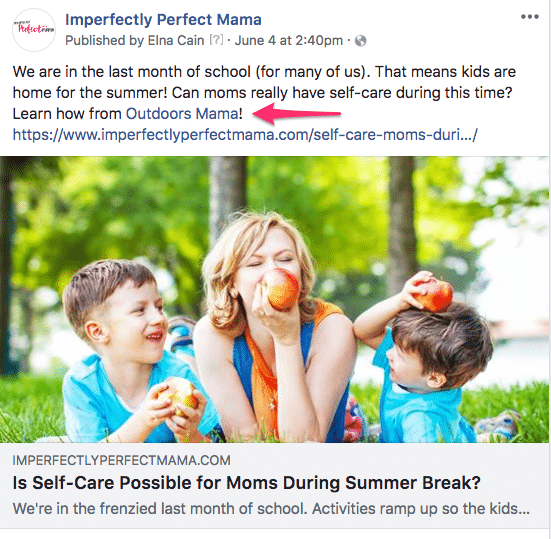
Blogger Outreach – How Do You Get Bloggers to Guest Post On Your Blog?
Now that you opened up your blog for guest writers, you need content for your blog! How do you attract guest bloggers to write for you?
Here are some promotional strategies for blogger outreach.
1. Create a Social Media Graphic
An easy way to promote your guest contributor blog is to create a “write for us” graphic and share that on social media or on your blog (or other blogs).
You can use this graphic to also promote in Facebook groups or even Pinterest groups.
2. Tell Your Email Subscribers
If you started an email list, a great way to get contributors is to tell your subscribers about your new blog or your new guest blog.
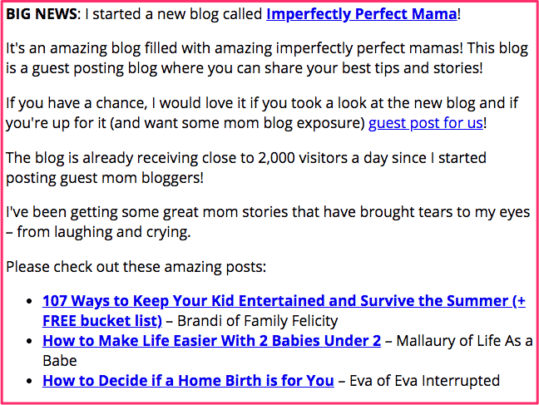
3. Reach Out to Other Bloggers
Finally, a great way to get some guest writers for your guest blog is to reach out to them and ask them to guest post for you! Yes, it’s a bold move, but if you create a template of sorts (while still being authentic and original each time you email a blogger), it becomes easier.
So, where do you find these bloggers?
- Pinterest – click on pins that are relevant to your niche and contact them
- On other guest blogs
For example, here’s an outreach email I sent to Jessica, a mom blogger.
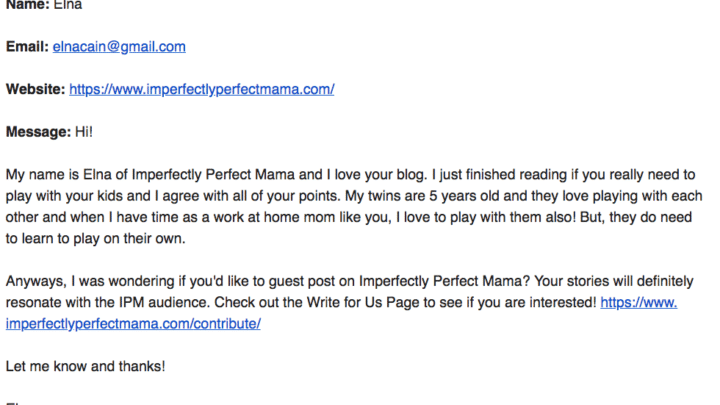
Before I reach out to bloggers to contribute to Imperfectly Perfect Mama, I make sure to read a few blog posts of theirs and connect with them when I contact the blog owner.
This is important as you don’t want your email to come off as a template or pitch.
Get Your Blog Ready for Multi-Authors
Whether you are gearing for the birth of your new baby or want to change your blog traffic strategy, opening up your blog for guest writers is a great way to grow your brand, audience and traffic!
Now, it’s your turn – do you have a guest blog? Share it in the comments!





25 Comments